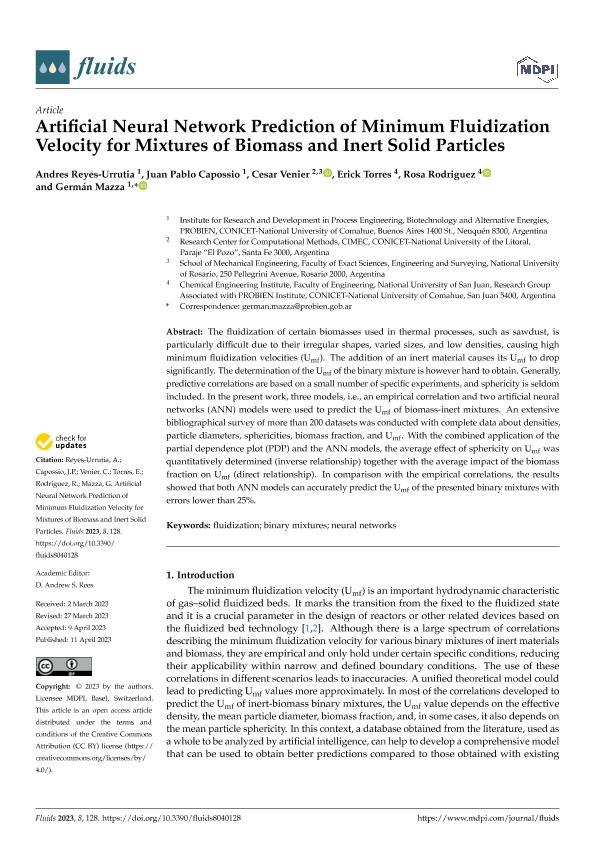Artículo
Artificial neural network prediction of minimum fluidization velocity for mixtures of biomass and inert solid particles
Reyes Urrutia, Ramón Andrés ; Capossio, Juan Pablo
; Capossio, Juan Pablo ; Venier, César Martín
; Venier, César Martín ; Torres, Erick David
; Torres, Erick David ; Rodriguez, Rosa Ana
; Rodriguez, Rosa Ana ; Mazza, German Delfor
; Mazza, German Delfor
 ; Capossio, Juan Pablo
; Capossio, Juan Pablo ; Venier, César Martín
; Venier, César Martín ; Torres, Erick David
; Torres, Erick David ; Rodriguez, Rosa Ana
; Rodriguez, Rosa Ana ; Mazza, German Delfor
; Mazza, German Delfor
Fecha de publicación:
05/2023
Editorial:
MDPI
Revista:
Fluids
ISSN:
2311-5521
Idioma:
Inglés
Tipo de recurso:
Artículo publicado
Clasificación temática:
Resumen
The fluidization of certain biomasses used in thermal processes, such as sawdust, is particularly difficult due to their irregular shapes, varied sizes, and low densities, causing high minimum fluidization velocities (Umf). The addition of an inert material causes its Umf to drop significantly. The determination of the Umf of the binary mixture is however hard to obtain. Generally, predictive correlations are based on a small number of specific experiments, and sphericity is seldom included. In the present work, three models, i.e., an empirical correlation and two artificial neural networks (ANN) models were used to predict the Umf of biomass-inert mixtures. An extensive bibliographical survey of more than 200 datasets was conducted with complete data about densities, particle diameters, sphericities, biomass fraction, and Umf. With the combined application of the partial dependence plot (PDP) and the ANN models, the average effect of sphericity on Umf was quantitatively determined (inverse relationship) together with the average impact of the biomass fraction on Umf (direct relationship). In comparison with the empirical correlations, the results showed that both ANN models can accurately predict the Umf of the presented binary mixtures with errors lower than 25%.
Palabras clave:
BINARY MIXTURES
,
FLUIDIZATION
,
NEURAL NETWORKS
Archivos asociados
Licencia
Identificadores
Colecciones
Articulos(CIMEC)
Articulos de CENTRO DE INVESTIGACION DE METODOS COMPUTACIONALES
Articulos de CENTRO DE INVESTIGACION DE METODOS COMPUTACIONALES
Articulos(PROBIEN)
Articulos de INST. DE INVESTIGACION Y DES. EN ING. DE PROCESOS, BIOTECNOLOGIA Y ENERGIAS ALTERNATIVAS
Articulos de INST. DE INVESTIGACION Y DES. EN ING. DE PROCESOS, BIOTECNOLOGIA Y ENERGIAS ALTERNATIVAS
Citación
Reyes Urrutia, Ramón Andrés; Capossio, Juan Pablo; Venier, César Martín; Torres, Erick David; Rodriguez, Rosa Ana; et al.; Artificial neural network prediction of minimum fluidization velocity for mixtures of biomass and inert solid particles; MDPI; Fluids; 8; 4; 5-2023; 1-18
Compartir
Altmétricas



